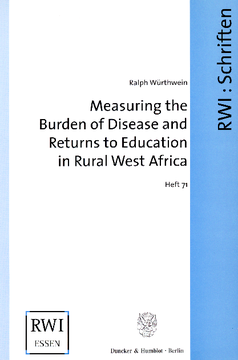Measuring the Burden of Disease and Returns to Education in Rural West Africa

BOOK
Cite BOOK
Style
Format
Measuring the Burden of Disease and Returns to Education in Rural West Africa
The Collection and Analysis of Mortality, Morbidity, and Socio-Economic Data in the Nouna Health District in Burkina Faso
Schriften des Rheinisch-Westfälischen Instituts für Wirtschaftsforschung, Vol. 71
(2003)
Additional Information
Book Details
Abstract
The success of health economics and its guidance for health policy heavily rests on the availability of reliable empirical evidence on the demographic, economic, and epidemiological environment, on behavioral relationships, and on the impact of policy interventions. For Sub-Saharan Africa, especially the epidemiological situation is unclear, since comprehensive systems of mortality and health statistics are often absent.The economic analysis of health naturally places a special focus on the interrelation between health and economic well-being: the overall disease burden decreases when a country grows richer, and the share of communicable diseases decreases in the process of economic development, whereas the share of non-communicable diseases increases. In those parts of Sub-Saharan Africa that are mainly dominated by traditional subsistence farming, however, it is difficult to examine questions of income and health for simple fundamental reasons. A vital prerequisite for an empirical investigation is the thorough and accurate measurement of income. Yet, both the measurement of the burden of disease and the measurement of income are research tasks that are far from being fulfilled for Sub-Saharan Africa. A further issue that is related with economic well-being and health is education. For poor rural regions predominated by traditional subsistence farming it is far from clear whether investments in human capital are worthwhile.The present study addesses this research gap by producing empirical evidence on the measurement of the burden of disease, the structure of income, and returns to education in rural West Africa. Concretely it deals with the collection and analysis of mortality, morbidity, and socio-economic data in the Nouna Health District in the North-West of Burkina Faso. The study was accepted as a doctoral thesis at the University of Heidelberg. Earlier versions of some of its chapters have been published as working papers or in international journals.
